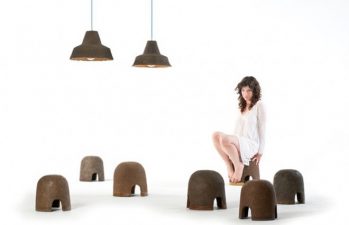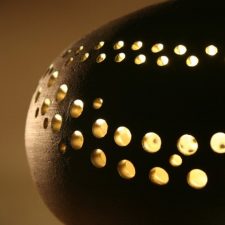 Israel-based design team creates an LED lamp packed with Lycopene and powered completely by tomatoes. Yum.
Israel-based design team creates an LED lamp packed with Lycopene and powered completely by tomatoes. Yum.
When it comes to energy-saving and eco-friendly design, we’ve seen some pretty nutso stuff already on Green Prophet. We’ve salivated over Hasadna’s ice cream spoon chandeliers, envied Merav Feiglin’s TrashLights, been impressed by Studio Mesila’s upcycled wood laminate lamps, and ogled KOZO’s lamps made out of reused plumbing tools. But a lamp that’s powered exclusively by produce? That’s… um…. new.
 Exhibited at the Milan Furniture Fair, this saucy lamp designed by Cygalle Shapiro of d-VISION is powered completely by juicy, red tomatoes.
Exhibited at the Milan Furniture Fair, this saucy lamp designed by Cygalle Shapiro of d-VISION is powered completely by juicy, red tomatoes.
A work of art as well as a statement about our energy usage, the “Still light” lamp is operated by a chemical reaction that takes place between the tomato acids, zinc and copper. The lamp is powered until the tomatoes become stale.
The large amount of tomatoes required to power the lamp draws the viewer’s attention to the amount of natural resources that we require for our energy consumption. Yes, the lamp is powered by tomatoes and not fossil fuel generated energy. But organic energy sources (such as tomatoes, apparently) require a lot of energy to produce as well and are not as “green” as they could be.
As the designer has described the “Still light” lamp, it is a “hybrid LED light system, integrating organic and metal parts within a single electrical circuit. Similar to a simple battery, the LED lamp is powered by an electrochemical reaction of copper and zinc electrodes placed in the tomatoes. The use of natural components gives the object an organic, finite life cycle; a reminder of life’s impermanence.”
d-VISION, a 2 year internship program for Product Development and Industrial Design, aims “to foster the next generation of outstanding industrial designers.”
Read more about funky green design from Israel:
Junktion’s Designs are the Intersection of Waste and Whimsy
Ten Sustainable Israeli Designers Who Reduce, Reuse & Recycle
Inspire Collective Brings 150 Artists Together for ReUse 3 Exhibition in Tel Aviv




This technology is out of this world.I began to imagine with the advancement in technology we can bring heaven don to earth.Tomatoe-powered led is such one beyond just thinking.
Actually, Iam looking for a tomatoes farming technology where you plant chemicalized tomatoe seedlings in a shelf,inside a room or in farm with roof up and then you use light bulb to control the temperature or supply light energy.
This takes few weeks to start fruits.It is quite big fruits and the varvest days are quite close.It is found in Isreal,China and America.pls write me and tell me where i can get this.counting on you.
Fascinating. An LED lamp powered by tomatoes. I work with Sharp and have been doing some research on LEDs. I thought I’d heard everything. But powered by produce is a new one. Even the LED lamps that are powered by electricity are very eco-friendly, use less energy, and are cost efficient. I think LEDs are the lighting of the future. LED lamp
Led lights are great because they are long lasting and consumes less electricity.`-`
Maybe this could work while we are waiting for green tomatoes to turn yellow. . .